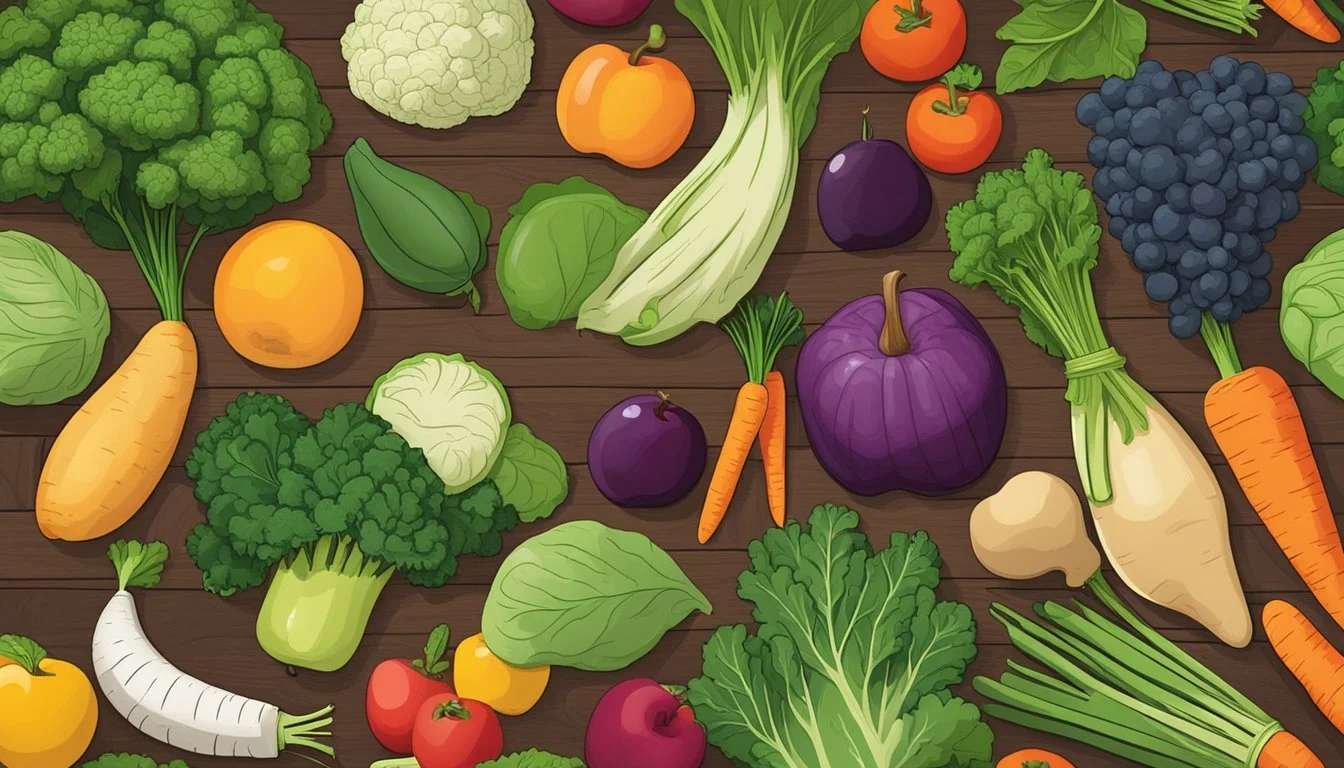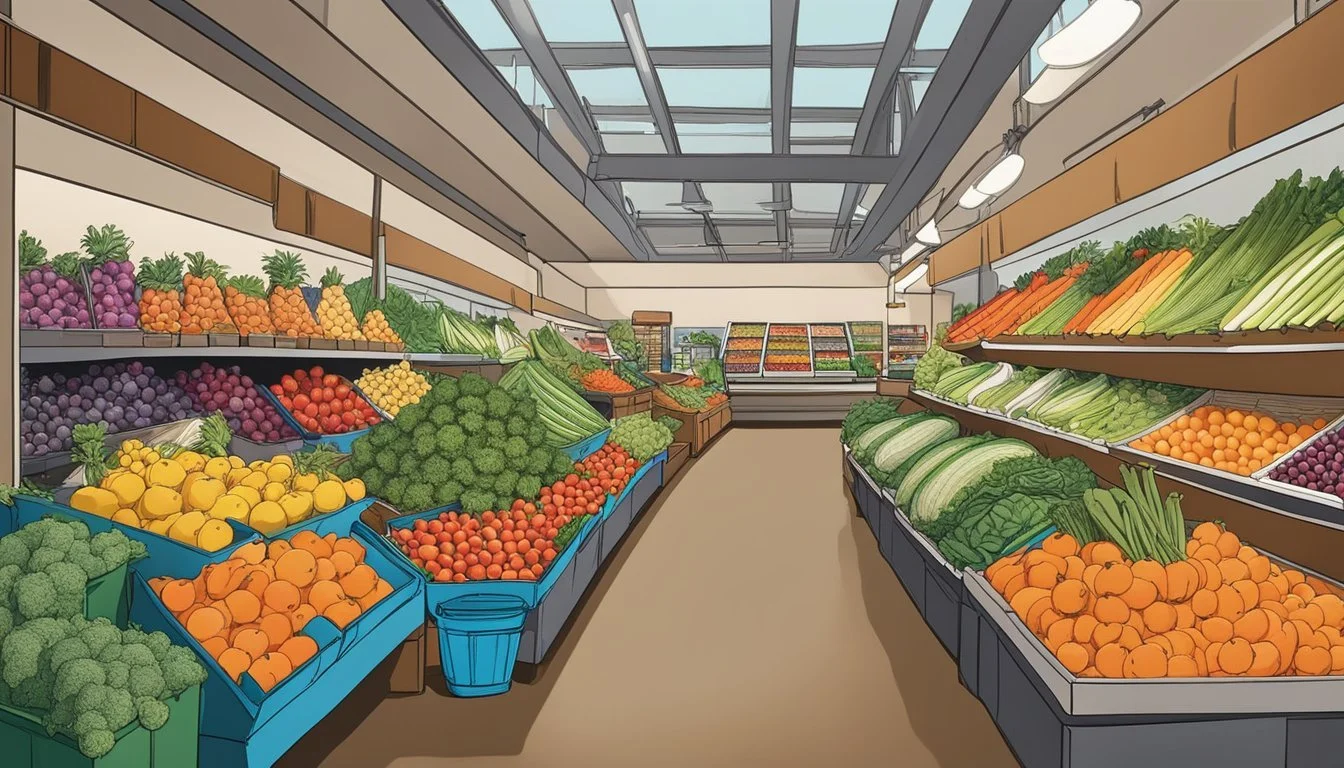Colorado Seasonal Fruit & Vegetables in March
Your Guide to Fresh Produce
This Article is Part of our Colorado Seasonal Fruit & Veg Calendar
March in Colorado marks a transitional period for fruit (What wine goes well with fruit?) and vegetable availability. As the last vestiges of winter melt away, the state's varied climate and geography begin to welcome the first hints of spring produce. While cold-resistant root vegetables like carrots, beets, and turnips continue to be mainstays, thanks to their ability to endure the frosty months, the month also sees the emergence of early spring harvests.
Local greenhouses start yielding fresh greens such as lettuces, kale, (What wine goes well with kale?) and spinach, providing a variety of options for salads and cooking. This period signals a shift in dietary preferences for many Coloradans, aligning with a growing desire for lighter meals as the temperatures gradually rise. Although the availability of certain crops may fluctuate due to weather conditions, the Colorado food landscape in March starts to reflect the coming changes of the season.
Seasonal Overview of Colorado Produce
In Colorado, March marks the transition from the dormant winter to the early whispers of spring, influencing the variety and availability of local produce. This shift plays a crucial role in the state's agricultural landscape.
March as a Transitional Month
March in Colorado is a season of transformation as the tail end of winter gives way to the onset of spring. While the climate remains cool, the longer days start encouraging new growth. Farmers and consumers alike anticipate the emergence of the first spring crops, although remnants of hearty winter produce still abound. Local greenhouses and hothouses extend the availability of some vegetables beyond their traditional seasons, bridging the gap during this changeover.
Typical Produce Available in March:
Leafy greens such as kale and spinach
Root vegetables like carrots (from storage) and turnips
Hardy greens including collards and mustard (how long does mustard last?)
Cruciferous vegetables such as cabbage and broccoli
Storage apples (how long do apples last?) lasting until early March
All-year crops produced in greenhouses like mushrooms and certain varieties of tomatoes and cucumbers
Importance of Seasonality in Colorado Agriculture
Seasonality heavily influences Colorado's agricultural output, with freshness and taste optimized when crops are harvested at their peak. The state's varied elevations and climates contribute to a robust and diverse growing season, while also posing unique challenges for farmers. Adhering to seasonal patterns is key to sustainability and benefits both the economy and the environment by reducing the need for transportation and storage. Shortening the farm-to-table journey ensures consumers access to fresh, nutritious, and flavorful produce.
Spring's Impending Impact:
Rejuvenation of soil and preparation for new plantings
Anticipation of asparagus (how long does asparagus last?) and other early spring vegetables
Colorado's landscapes gradually revive, setting the stage for abundant agriculture
By understanding the intricacies of Colorado's March produce offerings, consumers can select the freshest, most sustainable options and support local farmers as they navigate the seasonal transition.
Fresh Vegetables Available in March
In March, residents of Colorado can enjoy a variety of fresh vegetables as the season changes. This month is known for the rebirth of vibrant leafy greens as well as a selection of hearty root vegetables.
Leafy Greens and Brassicas
Spinach and Kale: As two of the most robust leafy greens, spinach and kale are readily available in March. Coloradoans value their versatility and nutritional content.
Broccoli and Cauliflower: These cruciferous vegetables start becoming more abundant, offering variety to the spring menu with their rich source of vitamins and minerals.
Cabbage: Known for its crisp texture, cabbage is another seasonal brassica that is excellent in salads or fermented as sauerkraut.
Lettuce and Collard Greens (how long do collard greens last?): Both come into season, delivering a fresh taste perfect for salads or as a cooked side dish.
Root Vegetables and Others
Root Vegetables:
Beets: With their deep red hues, beets are not just flavorful but also packed with nutrients.
Carrots: Crunchy and sweet, they are ideal for both raw snacking and cooking.
Potatoes: An all-time favorite, they continue to be a staple, perfect for a variety of dishes.
Others:
Leeks and Onions: These aromatic vegetables contribute depth to any dish they are added to.
Radishes: Adding a peppery kick, radishes are perfect for a fresh spring salad.
Peas: Pea greens, and peas themselves, begin to make their way into the market, signaling the start of the season.
Seasonal Fruits to Enjoy
March in Colorado sees a transition in available produce. It heralds the end of winter's citrus and the continued enjoyment of storage fruits such as apples.
Apples and Pears
In March, apples are typically available from storage, providing a crisp and sweet option that has been preserved to last through the winter months. Apples vary in flavor and texture, so consumers can enjoy a range of types suitable for eating fresh or for use in cooking and baking recipes. Pears, also available from storage, offer a juicy and tender ingredient for a variety of dishes.
Late Winter Citrus
While many associate citrus fruits with warm climates, certain types can be found in markets during the tail end of winter. Oranges and lemons remain available, serving as zesty and refreshing ingredients that can brighten up recipes. These citrus fruits are valued for their high vitamin C content and for delivering fresh flavor to dishes, despite the chill of winter.
Herbs and Additional Crops
In March, Colorado gardeners can anticipate the growth of various herbs and additional crops that thrive in early spring's cool temperatures. Accessibility of these crops may vary depending on local climate variations and specific growing conditions.
Herbs:
Parsley often perseveres through Colorado's variable March weather, offering its fresh, vibrant leaves.
Basil seedlings can start indoors, preparing for transplant when the frost risk has passed.
Arugula, while typically started in May, can sometimes be available from hothouses year-round.
Vegetables and Leafy Greens:
Chard, with its robust nature, begins to be available — a leafy green that's both versatile and nutritious.
Celery, though less common in garden plots due to its long growing season, may still be found in local markets from storage or as an early kick-off from greenhouses.
Colorado's March landscape also yields a variety of other cool-season crops and overwintered produce, such as root vegetables and storage apples, before the full onset of spring ushers in a wider array of produce. Gardeners and consumers alike should stay attentive to local harvest calendars for the most accurate and timely information regarding availability.
Health Benefits of Seasonal Eating
Eating seasonal produce offers multiple health benefits to consumers. When fruits and vegetables are harvested in their appropriate season, they are often fresher and provide a higher nutrient content. This is particularly crucial, as nutrients such as vitamins and antioxidants are at their peak levels in fresh produce, which can contribute to better health and disease prevention.
Seasonal fruits and vegetables can also enhance the flavor of meals. It is widely recognized that produce picked during its prime season tends to have a richer, more fully developed taste. This is especially important for dishes where produce is the star, such as salads and certain cooking applications where the natural flavors are meant to shine.
Incorporating seasonal items into one's diet can lead to a greater variety of foods consumed throughout the year, contributing to a diverse intake of vitamins and minerals. For instance, individuals may use specific seasonal items like leafy greens in salads to add a fresh and nutritional element to their daily meals.
Below is a simple breakdown of the benefits:
Freshness: Seasonal produce is often harvested at peak ripeness, leading to higher quality.
Nutrient-Rich: Greater nutrient density is generally found in produce that hasn't been stored for long periods.
Flavorful: Fruits and vegetables in season boast enhanced flavor profiles.
Variety: Eating with the seasons introduces a wider range of foods into the diet, contributing to culinary diversity.
Emphasizing seasonal eating aligns consumers with produce that supports their health while providing a culinary experience rooted in the best that each season has to offer.
Cooking and Recipes
In March, Colorado offers a variety of seasonal vegetables that inspire a wide array of cooking methods and recipes. The flavors of the season can be encapsulated through roasting, stewing, and fresh salad preparations.
Preparing Seasonal Vegetables
Vegetables such as asparagus and radishes are at their peak in Colorado during March. For asparagus, roasting is a method that enhances its natural flavors. Simply toss asparagus spears with olive oil, salt, and pepper, and roast them in a preheated oven at 400°F (200°C) for 12 to 15 minutes. They should be tender yet slightly crisp.
On the other hand, radishes provide a peppery kick and are often used to complement salads. One can slice them thinly and toss them with salt, lemon juice, and a drizzle of olive oil for a simple side dish. Radishes also add a crunchy, spicy element when mixed into butter-based roasts or stews.
Fruit-Based Dishes
While not as abundant as vegetables, March still offers some fruit options that can be turned into flavorful dishes. Utilizing fruits in savory applications, such as adding them to salads, can bring a fresh twist to meals. Citrus fruits, which remain available, can be segmented and added to salads for a burst of flavor.
For a fruit-based recipe, one might consider making a compote or glaze with available fruits to serve alongside a dessert or a main dish. Cooking down the fruit with a touch of sugar and perhaps a hint of butter can create a sauce that enriches the flavor profile of both sweet and savory dishes.
Local Markets and Produce Availability
In March, shoppers in Colorado have access to various markets offering fresh, locally harvested produce. The key to finding the best selection lies in knowing where and when to shop, and understanding the importance of building relationships with local growers.
Finding Fresh Produce in Colorado
Individuals looking for fresh produce in Colorado can frequent farmers' markets, which offer a variety of seasonal items. During the month of March, while outdoor farmers' markets may just be starting up for the season, there are still indoor markets and year-round locations that provide access to fresh produce. Consumers can expect to find items such as:
Storage crops: apples, carrots
Winter-hardy greens: kale, collards
Root vegetables: turnips
March marks the end of storage crop availability and the beginning of early spring harvests, weather permitting.
Connecting with Local Growers
Engaging with community-supported agriculture programs (CSAs) or visiting local farm stands allows shoppers to connect directly with Colorado growers. These connections not only support the local economy but also offer insight into the produce's cultivation processes and availability. Relationships with local growers can lead to a deeper understanding of seasonal availability and may provide opportunities for purchasing produce at its peak freshness.
By shopping at local markets and participating in community-supported agriculture, individuals in Colorado play an integral role in sustaining the local agricultural community while enjoying the benefits of fresh, seasonal produce.
Agricultural Practices in Colorado
Colorado's agricultural sector employs a variety of practices to ensure a sustainable and productive harvest during the growing season. Colorado's climate and geography significantly influence the type of agriculture and the specific practices used across the state.
Sustainable Farming: Farmers in Colorado emphasize sustainable farming techniques, aiming to conserve water, maintain soil health, and reduce the carbon footprint. Crop rotation, cover cropping, and integrated pest management are common practices helping to preserve Colorado's diverse ecosystems.
Growing Season: The Colorado growing season varies by region but typically starts in late April and extends through October. March marks the preparation period for many growers as they ready their fields for planting. Depending on the microclimates within the state, some areas may already begin early seeding of cool-weather crops.
Irrigation: Given the semi-arid climate, irrigation is crucial in Colorado agriculture. Advanced irrigation systems are used to maximize efficiency, including drip and overhead sprinkler systems, which help conserve water.
Harvest Techniques: Harvesting methods are tailored to both the season and the particular produce. In March, farmers may still be gathering the last of the winter storage crops and beginning to harvest early spring produce.
Crop Selection: Colorado cultivates a range of crops, including:
Winter crops such as storage apples harvested up to early March.
Spring crops with some greens like arugula that thrive in cooler temperatures.
Local Associations: Organizations like the Colorado Fruit and Vegetable Growers Association provide resources and support for local farmers, promoting practices that align with both agricultural sustainability and market demands.
Planning Ahead for The Growing Season
March marks a pivotal time for Colorado gardeners and farmers as they gear up for a productive growing season. Preparation is key to ensure a bountiful harvest in the months to come.
April and May Harvest Preparations
In Colorado, the onset of spring in April signifies the start of the harvest for certain crops, and preparations must begin a month prior. Gardeners and farmers should start by readying the soil, considering its quality and nutrient levels. They may need to incorporate compost or other organic matter to foster optimal plant growth.
Crucial Tasks for March:
Assessing and amending soil
Starting seeds indoors for transplanting
Planning irrigation systems
Expected April Harvest:
Morels
Nettles
Looking Forward to Summer Crops
May serves as a bridge to summer, and it's crucial to prepare for the heat-loving crops that will be planted. Colorado's summer bounty includes a vivid array of fruits and vegetables that require attention now to thrive later.
Key Actions for March:
Ordering seeds for summer crops (e.g., tomatoes, peppers, cucumbers)
Preparing protection strategies against late frosts
Farmers typically utilize this time to ensure equipment and supplies are ready for the intense season ahead. By the end of March, with the groundwork laid, Colorado's agricultural community anticipates the rhythm of planting and harvest that cycles through the warmer months.
Conclusion
March in Colorado presents a transitional period in the state's agricultural calendar. It is at this time that the last of winter storage crops are being consumed and the early spring harvest begins, depending on weather conditions. Root vegetables such as carrots, which are stored through the winter, are often still available, as well as hearty greens like kale.
Typical Produce Available in March:
Root Vegetables: Carrots (from storage)
Greens: Kale, Arugula, Lettuce
Herbs: Parsley, Cilantro
Emphasis should be placed on the variability of the harvest due to factors including geographical location, elevation, and fluctuating weather patterns. Consumers can generally expect that as March progresses, the availability of fresh, locally-grown produce will expand, leading into the abundance of the spring and summer months.
It's also essential to note that cold-hardy greens such as arugula are among the first to appear in gardens and on market stands. Producers may have greenhouses or utilize other season-extension methods, allowing for the availability of some fresh produce that otherwise wouldn't be available until later in the season.
For the most current and specific information on availability, one should contact local farmers' markets and individual growers, as they can provide updates on the exact timing of their crops' availability. This will support local agriculture and ensure that consumers are purchasing the freshest produce possible.









